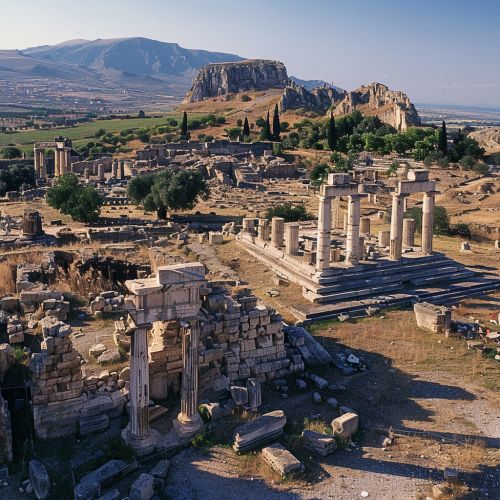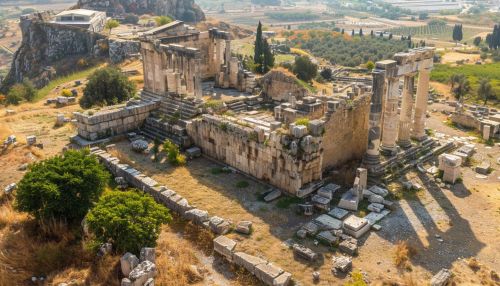Corinth
History
Corinth, an ancient city in Greece, has a rich history that spans several centuries. The city was founded in the Neolithic period around 6000 BC, making it one of the oldest cities in Europe. The city's strategic location at the crossroads of land and sea routes contributed to its growth and prosperity in the ancient world.
The city-state of Corinth played a significant role in the development of ancient Greek civilization. It was a major center of commerce, art, and military power in the Archaic and Classical periods. The city was known for its skilled craftsmen and artists, who contributed to the development of Greek sculpture, pottery, and architecture.


In 146 BC, Corinth was destroyed by the Romans during the Achaean War. The city was rebuilt by Julius Caesar in 44 BC and became an important center in the Roman Empire. During the Roman period, Corinth was known for its wealth and luxury, and it was a major center of early Christianity.
The city was destroyed again by an earthquake in 365 AD and was subsequently rebuilt. Corinth continued to be an important city in the Byzantine Empire and later in the Ottoman Empire. The modern city of Corinth was founded in 1858 after a devastating earthquake destroyed the ancient city.
Geography
Corinth is located in the northeastern part of the Peloponnese peninsula in southern Greece. The city is situated on the narrow isthmus that connects the Peloponnese to the mainland of Greece. This strategic location made Corinth an important center of trade and transportation in the ancient world.
The city is surrounded by fertile plains and hills, which provided the ancient Corinthians with agricultural products such as grain, olives, and grapes. The city is also close to the Gulf of Corinth, which provided access to the sea and facilitated trade with other parts of the Mediterranean.
Architecture and Art
Corinth was known for its distinctive style of architecture and art, known as the Corinthian style. This style is characterized by its elaborate and ornate designs, which were often used in the construction of temples, public buildings, and private homes.
The most famous example of Corinthian architecture is the Temple of Apollo, which was built in the 6th century BC. The temple is known for its distinctive columns, which are decorated with acanthus leaves and scrolls.
Corinth was also known for its pottery, known as Corinthian ware. This type of pottery was characterized by its intricate designs and high-quality craftsmanship. Corinthian ware was highly sought after in the ancient world and was exported to many parts of the Mediterranean.
Economy
The economy of ancient Corinth was based on agriculture, trade, and craftsmanship. The city's strategic location on the isthmus of Corinth made it a major center of trade in the ancient world. Goods from all over the Mediterranean were transported through Corinth, which contributed to the city's wealth and prosperity.
The city was also known for its skilled craftsmen, who produced high-quality goods such as pottery, textiles, and metalwork. These goods were exported to other parts of Greece and the Mediterranean, further contributing to the city's economy.
Religion
Religion played an important role in the life of ancient Corinthians. The city was home to several temples and sanctuaries dedicated to various gods and goddesses. The most important of these was the Temple of Apollo, which was the city's main religious center.
The city was also known for the Isthmian Games, a religious festival held in honor of the god Poseidon. The games were one of the four major athletic competitions in ancient Greece, along with the Olympic Games, the Pythian Games, and the Nemean Games.
